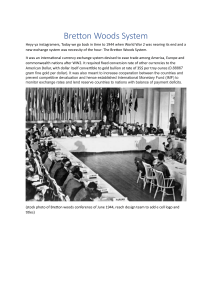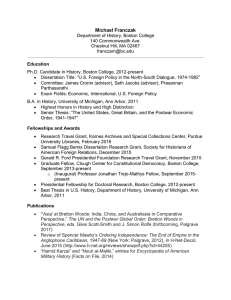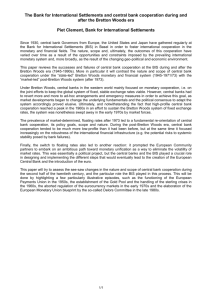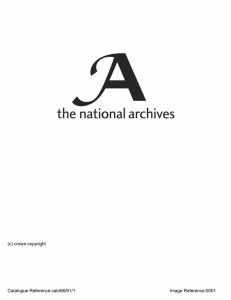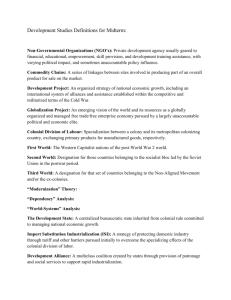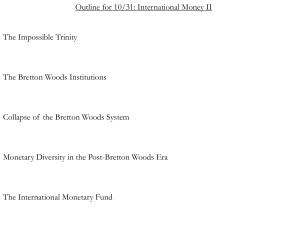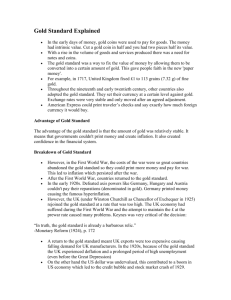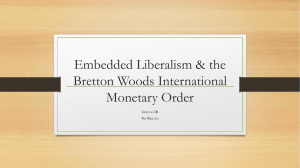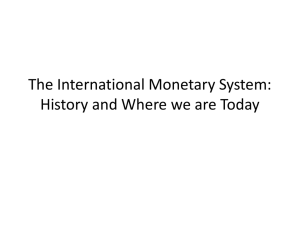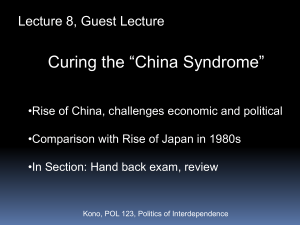12-2
advertisement
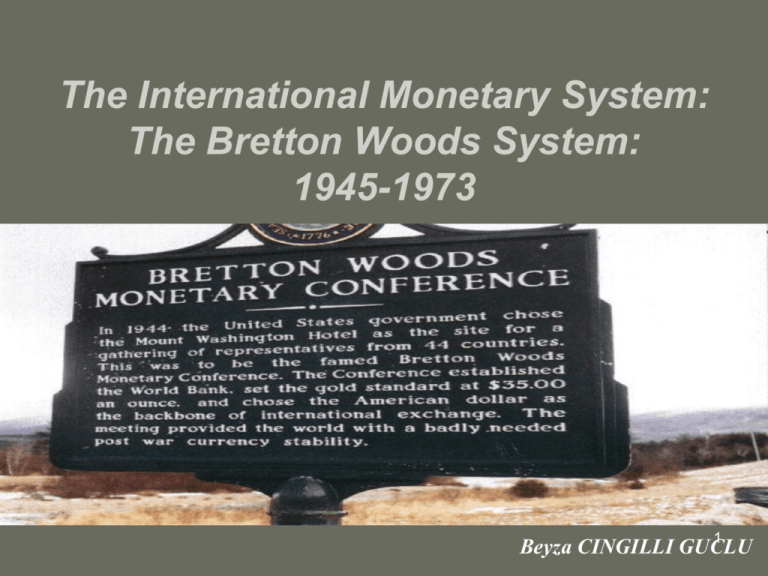
The International Monetary System: The Bretton Woods System: 1945-1973 1 Beyza CINGILLI GUCLU - In July 1944, to design an international monetary system administered by an international organization, delegates from 44 countries met in a small town named after the conference “Bretton Woods”, New Hampshire In the conference, the countries drafted and signed the Articles of Agreement of the International Monetary Fund (IMF), thus the Bretton Woods system was created. - Key actors: Harry D. White (U.S.) and J.M Keynes (G.B.). Both agreed that stable exchange rates foster trade. But both also saw that full-employment concerns meant that a return to permanently fixed rates was impossible 2 1. Exchange rate stability and the IMF (27 December 1945), Three Pillars of the Bretton Woods System 2. Recovery and development (International Bank for Reconstruction and Development, now known as the World Bank), 3. Liberalization of trade via the General Agreement on Tariffs and Trade (GATT) in 1947. 3 The Bretton Woods System - A stable and fixed but adjustable exchange rates regime - Allied countries to fix their exchange rates by tying their currencies to the U.S. dollar (dollar-pegged exchange rate) - The U.S. dollar to be linked to gold; per ounce at $35 - Currencies to be kept within 1% of the fixed rate - Golden age of the U.S. dollar - The system’s stability required price stability in the US 4 Expected Benefit from the New System - Through capital controls, the countries would pursue the full employment and price stability (low inflation) and the external balance (keeping exchange rates stable) simultaneously. 5 Source: 6 Broz, Lawrance, Bretton Woods System, 2005. Retrieved from http://weber.ucsd.edu - Pegged exchange rates Similarities to the Gold Standard - Gold was the ultimate numeraire (dollar pegged to gold at $35 per ounce) 7 - Only U.S.dollar pegged to gold; all others pegged to the U.S. dollar, none of these currencies were convertible to into gold. Differences with the Gold Standard - Deflationary policy, which was a classic medicine for chronic BOP deficits in the gold standard was no longer a must, the adjustable peg was an improvement over the gold exchange standard with fixed parity. 8 N-th currency problem: the change in dollar’s value in terms of gold has no real effect. - Problems - Over-sighted national policies: Occasional devaluations under the supervision of the IMF to remove “fundamental disequilibria” in the balance of payments (BOP). (Fundamental disequilibria: A country suffering permanent adverse shifts in the demand for its products. Without devaluation, a long period of unemployment and external deficits would be expected.) 9 - The reserves of most countries became a mixture of gold and dollars. - In 1958, countries in Europe completed the restoration of convertibility. -National interest rates were closely linked with each other due to the opportunity to move funds across borders. Evolution and Breakdown -“Disguised Capital Flows” increased (leads and lags). - Current Account deficits and surpluses also took attention. A country with large and persistent current account deficit was suspected of being in “fundamental disequilibria”, thus ready for a currency devaluation. “Suspicion of an impending devaluation could, in turn, spark a balance of payment crisis”. Balance of Payment crisis were frequent in 1960s and early 1970s due to speculative attacks. In 1970s the crisis were so massive that finally countries couldn’t keep up with the adjustments, so the system collapsed and replaced with a 10 regime of floating exchange rates. EXAMPLE If Britain devaluated pound due to a CA deficit, the foreign currency value of pound assets would decrease, thus savings would shift into other currencies. In order to hold the pound’s exchange rate against the dollar pegged, the Bank of England should sell foreign assets to market and buy pounds instead. Now, without enough reserves, the foreign reserves’ loss might cause a devaluation, if large enough. 11 References - The Bretton Woods System. Retrieved from http://econ2.econ.iastate.edu - Time Magazine, 21 October 2008, A Brief History of Bretton Woods System. Retrieved from http://www.time.com/time/business/article/0,8599,1852254,00 - Broz, Lawrance, Bretton Woods System, 2005, retrieved from http:// weber. ucsd.edu 12
